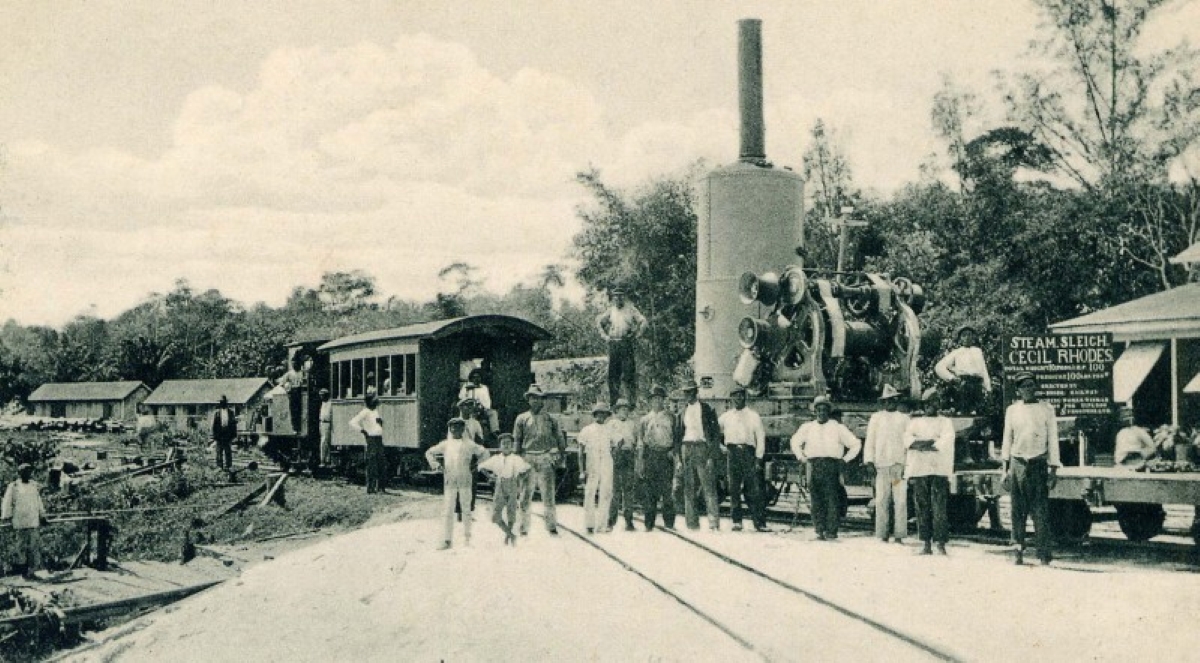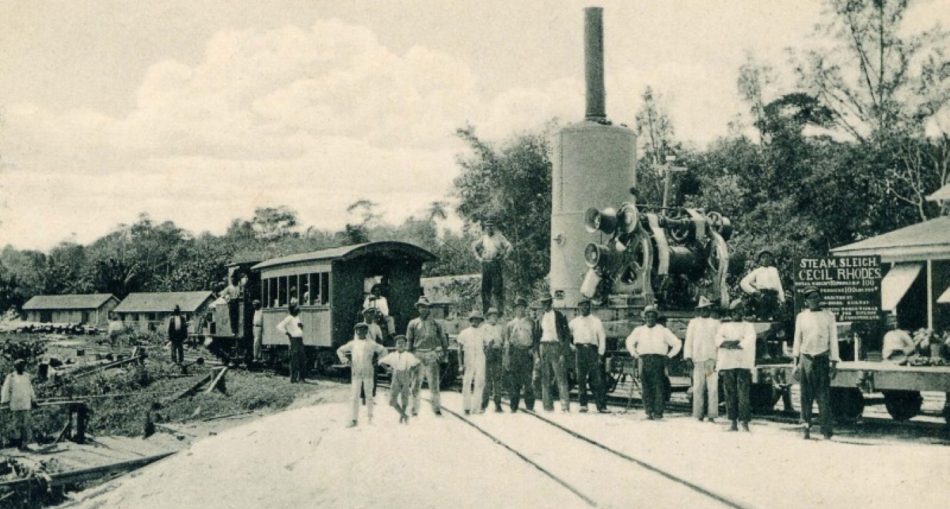The Demerara-Mahaica Railway was the first railway system implemented in British Guyana and South America. It was built only twelve (12) years after the first railway was built in England. Planters and proprietors on the East Coast of Guyana sought a cheaper way of transporting their produce to the capital of Georgetown since it was costly to transport their produce by river in schooners and vessels. With the approaching emancipation of slaves, they also were in need of new labour and thought of replacing manual labour with machinery and thus the idea of constructing an iron railway was birthed. The Demerara Mahaica Railway extended from Georgetown to Rosignol and was built in sections. Throughout its lifespan, the railway provided efficient service especially to passengers, which generated a large part of its revenue. The project of constructing the Demerara-Mahaica Railway had many difficulties, mainly financial which lead to its closure. Read on to find out about the first railway system in South America.

Steam Slide Cecil Rhodes’ at the Demerara Essequibo Railway – Photo By Unknown photographer – Dmitri Allicock: The Demerara Essequibo Railway (DER) and *.jpg, Public Domain, https://commons.wikimedia.org/w/index.php?curid=47446523
What is the Demerara-Mahaica Railway?
The Demerara-Mahaica Railway that operated from Georgetown to East Coast was the first railway in the country and took about eighteen (18) years to complete. The West Coast Railway was built shortly after. The Demerara-Mahaica Railway provided access to easy transporting of produce and supplies and so persons living in Georgetown would be able to regularly receive meat and milk from the cattle farms on the East Coast. In addition, the planters would have been able to easily transport their troops and provisions. While the original purpose of the Demerara-Mahaica Railway was to facilitate the transportation of cargo, it became a passenger service railway, which accounted for four-fifths (4/5) of the generated revenue.
Later in the year of 1863 two locomotives, Victoria and Alexandra arrived in Guyana. Alexandra worked as a relief engine for the Transport Department. Later in that year, two new locomotives arrived in the Colony, they cost £1,425 each and were named “Georgetown” and “Mahaica”. Three steam engines were imported from England and named Mosquito, Sandfly and Firefly.
History of the West Coast Railway
On 10th March 1837, a general meeting was held where planters and proprietors decided that a railway system was necessary to substitute mechanical for manual labour, especially as the emancipation of the slaves approached. They decided the East Coast of Demerara proposed feasibility for the construction of a railway and thus through an election, a committee was appointed to oversee the construction. However, it seems due to the expenses the idea was later abandoned.
During a meeting of the General Committee of the Agricultural and Commercial Society of British Guiana, on 10th February 1845, expressed their desire to construct a railway linking Georgetown to Mahaica. While most of the original committee members were presents, Hon. H. E. F. Young (Government Secretary) presided. A draft of the proposed railway was later examined by a sub-Committee and the idea took root. Funds were raised abroad to finance the £150000 project. Two thirds (2/3) of the thirteen shares were awarded to applicants in Europe. A survey of the lands was needed and so Frederick Catherwood, a Consulting Engineer in England, was chosen for the task. He had experience in England’s and North America’s railroads. In April 1846, he submitted a preliminary report and plans were handed to the local Committee. The construction of the Demerara-Mahaica Railway later began by Frederick Catherwood in March 1847.
The Demerara Railway Company purchased a plot of land on the junction of Main and Lamaha Street in Georgetown where the Georgetown terminus was built. In the same year, 1847, a large railway station with workshops, coal sheds and large water tanks were built at the location. Later on, the construction of the other stations began. The steam engines, Mosquito, Sandfly and Firefly were imported around this time. The Demerara-Mahaica Railway was opened on 3rd November 1848 from Georgetown to Plaisance.
As the construction progressed, cost increased and the government intervened to assure repayment of loans. Around May of 1849, Frederick Catherwood’s contract was brought to an end due to dissatisfaction with his service. Once again the government stepped in and approved a loan of £50,000. Mr. Manifold who previously worked with Catherwood oversaw the construction and in March, October and November 1850 the Demerara-Mahaica Railway was extended to Buxton, Enmore and Belfield respectively.
Due to difficulties in financing the project, it took about two (2) years to reach Two Friends. By the time it reached here, funding was depleted and the government then funded the rest of the railway to Mahaica. The railway way later extended to reach Clonbrook in 1863 and Helena (Mahaica) in August 1864. Two locomotives arrived in 1859 which was lent to the company. Due to the popularity of the Demerara-Mahaica Railway and the demands of the people, the government granted the line to be built from Mahaica to Rosignol which was constructed from 1897 to 1900. Its terminus was the ferry stelling on the left bank of the Berbice River.
On 1st January 1922, the Demerara-Mahaica Railway was sold to the Colonial Transport Department of the Government of British Guiana which took over management and control. However, President Forbes Burnham decided to terminate the operating of the public railway system in the early 1970s and the terminus on Lahama Street was converted to a bus terminal.
Route of the West Coast Railway
The Demerara-Mahaica Railway stretched some ninety-seven point four (97.4) km along the coast from Georgetown to Rosignol in Berbice. The railway was built in sections and so the route traversed was extended over time. The Georgetown Plaisance section was completed in 1848 with a total of two (2) trains operating daily. In 1854, the railway was extended to Belfield and later on to Mahaica in 1864. Around 1897 to 1900, the Demerara-Mahaica Railway was once again extended, this time reaching to Rosignol. Between Georgetown and Rosignol there were four (4) stations,
The lay of the land was relatively easy to build on as there weren’t any additional excavation or making of tunnels to be done. The depressions were bridged over with masonry and some were replaced by embankments. Three major bridges that the Demerara-Mahaica Railway crossed were over Mahaica, Mahaicony and Abary rivers. There were several stations were the trains made their stops including, Georgetown, Plaisance, Buxton and Rosignol.
The operating features of the East Coast railway line of the Demerara-Mahaica Railway differed from Georgetown. The height of traffic was in the morning and afternoon when passengers travelled to and from Georgetown. Passengers were mainly workers, school children and marketing villages. Between six forty-five (06:45) and eleven (11) a.m. there were six trains arriving at the terminus. After this busy period, the next train came about six (6) p.m., followed by two (2) more to cater for the afternoon traffic. On the Georgetown end, two trains left in the morning and returned at six (6) in the afternoon. These trains usually called for an early start from the stations in the country where they were stationed overnight or emptied, however, the procedure of maintaining the carriages were expensive.
The Demerara-Mahaica Railway of Guyana
The Demerara-Mahaica Railway had its share of financial difficulties from the conception of the idea in 1845. The railway changed ownership from Demerara Railway Company to the then Government of Guyana enabled access to funds during the length of the project. The Demerara-Mahaica Railway provided efficient service in the transportation of good and passengers until its end in the 1970s, when it was replaced with the introduction of bus service like the West Coast Railway.
Article References
- https://en.wikipedia.org/wiki/Railways_in_Guyana
- https://www.stabroeknews.com/2008/12/25/features/history-this-week-28/
- https://www.stabroeknews.com/2009/02/12/features/history-this-week-no72009/
- https://www.stabroeknews.com/2009/04/30/features/history-this-week-37/
- https://www.thingsguyana.com/the-west-coast-railway-1897-1971-transportation-of-a-colonial-guyana/
- https://www.gysbi.com/fullscreen-page/comp-jm974zvn/4145a946-a1d8-485d-b569-2420141e9e30/24/%3Fi%3D24%26p%3Dc1dmp%26s%3Dstyle-jm974zx4
- http://www.guyana.org/features/guyanastory/chapter73.html







